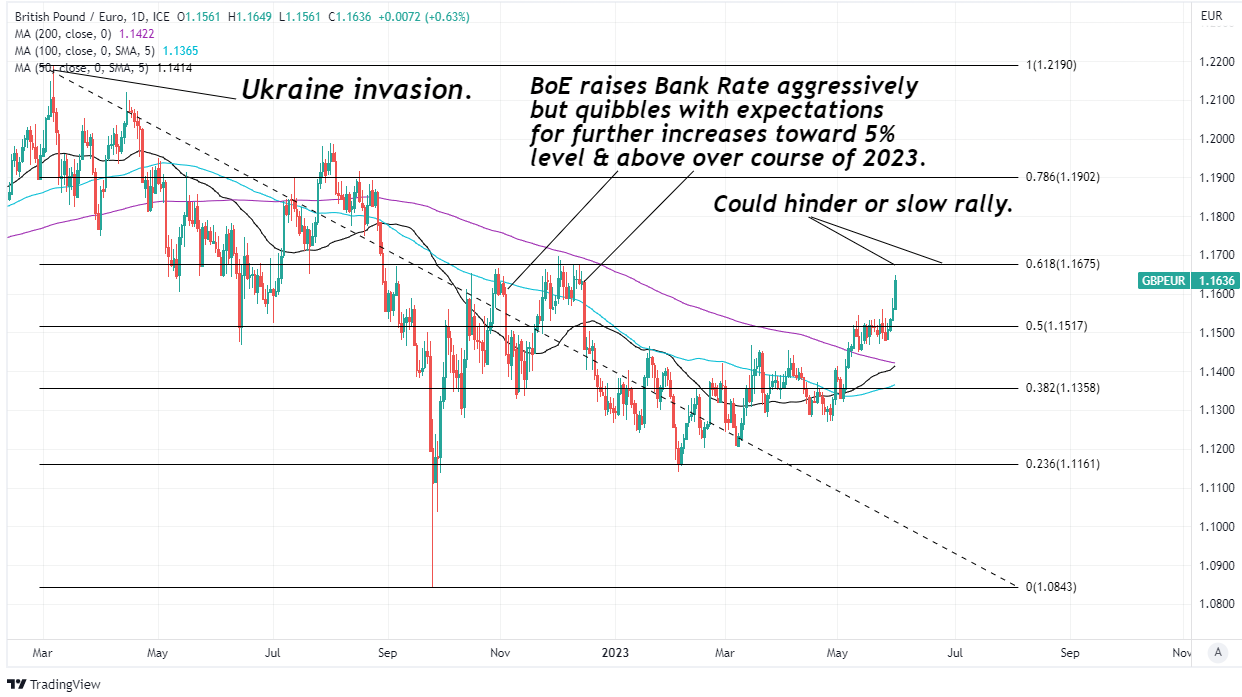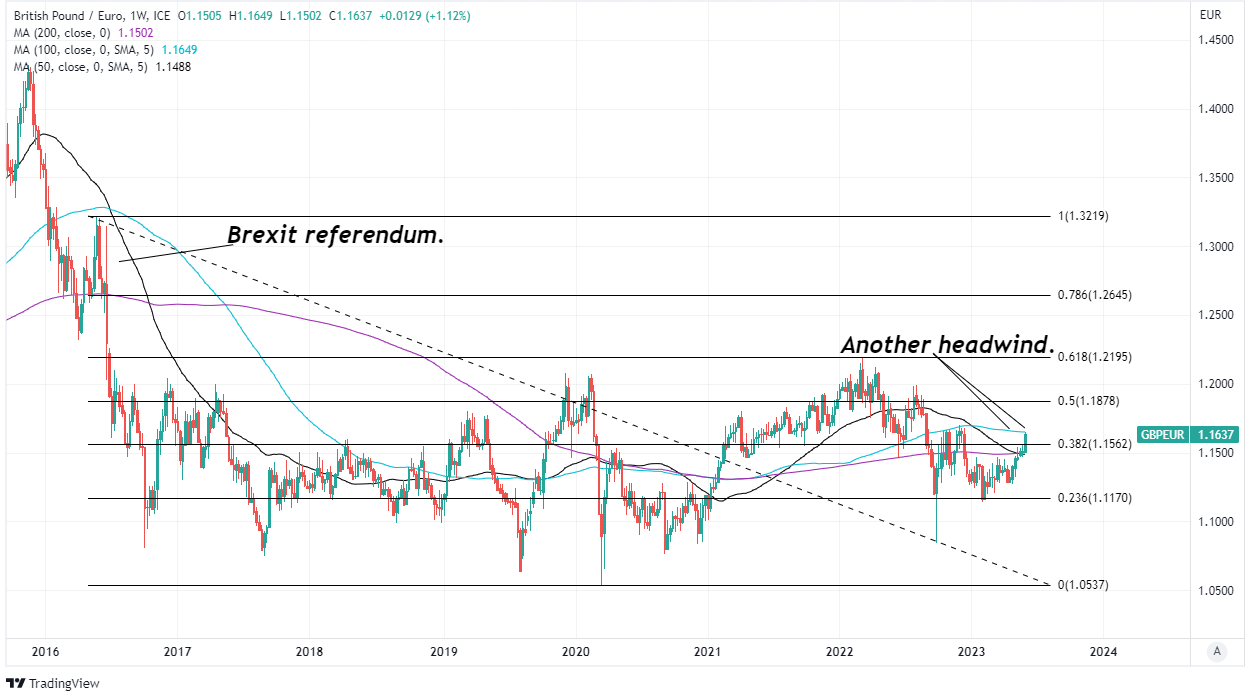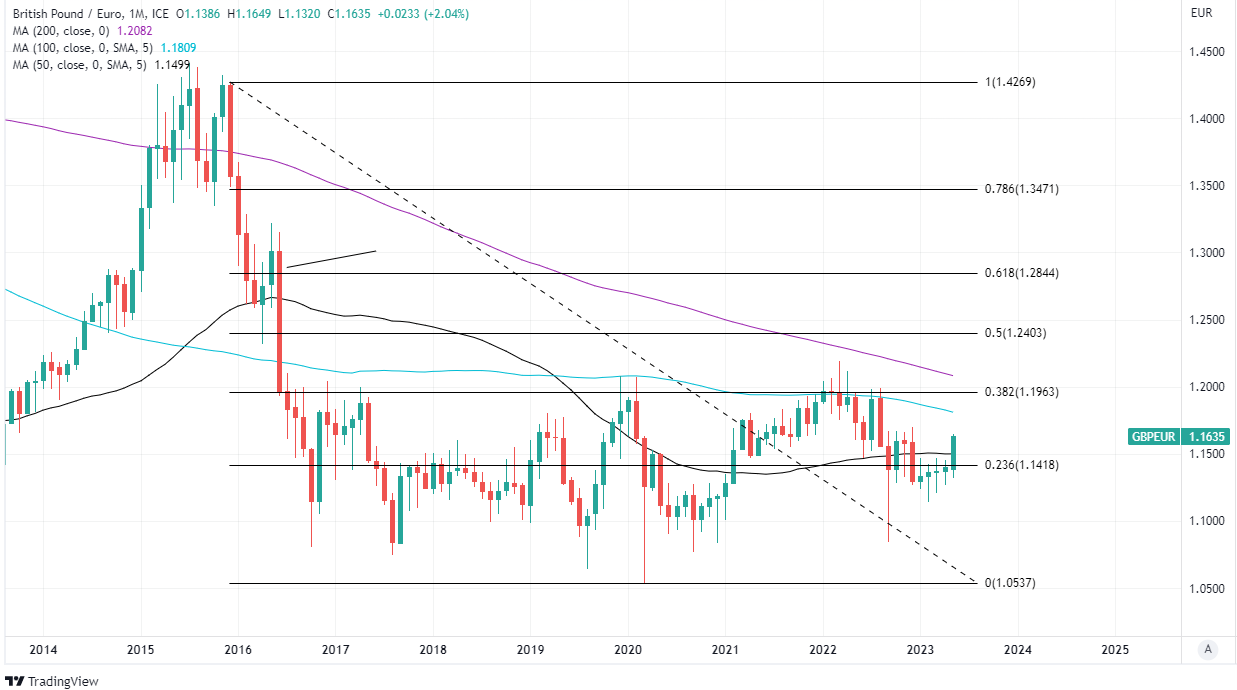GBP/EUR Rate at Landmark Levels but Fresh Trials and Tribulations Ahead
- Written by: James Skinner and Gary Howes
- GBP/EUR at 6-month highs
- As German inflation disappoints and GBP extends gains
- Chart resistance lies above
- "I am adding the EURGBP short to the sidebar"

Image © Adobe Images
The Pound to Euro exchange rate (GBPEUR) reached a fresh six-month high Thursday at 1.16 as Pound Sterling extended its rates-driven rally and the Euro was hamstrung by Eurozone inflation figures.
GBPEUR extended its winning streak after Eurozone core inflation was reported at 5.3% in May, down from 5.6% a month prior and below consensus forecasts for 5.5%. The figures follow Wednesday's below-consensus German inflation figures and firm expectations that the European Central Bank (ECB) can consider slowing its rate hiking cycle sooner than previously expected.
By contrast, inflation in the UK is running above expectations and investors expect further hikes from the Bank of England, in turn supporting UK bond yields. Higher bond yields in the UK relative to the Eurozone are a key driving force behind capital inflows into the UK that boost the Pound's value relative to the Euro.
Euro losses have helped the Pound break through a stubborn pocket of resistance between 1.1515 and 1.1562 on the charts, which had frustrated its recovery through much of the last month while leading to a win for strategists at Goldman Sachs who tipped Sterling as a buy with a 1.1627 target back when it was trading around 1.15 in the middle of May.
The break above 1.15 has since acted like a magnet for others who've cited various reasons for why the trend could have further to run in the days ahead.
"I am adding the EURGBP short to the sidebar, despite a meh entry point as I think EURGBP is breaking down after trading 0.8720/0.8920 all year," says Brent Donnelly, President at Spectra Markets and a veteran currency trader with a career spent between hedge funds and global banks such as HSBC and Nomura.
Above: Pound to Euro rate shown at daily intervals with Fibonacci retracements of 2022 fall indicating possible areas of technical resistance.
Donnelly cites the outlook for German inflation and the recent surge in UK government bond yields for thinking Sterling could continue to rise for a few days yet and has suggested 1.1842 (GBP/EUR) as a target, which equates to 0.8444 in EUR/GBP terms.
Pound-Euro meanwhile faces other technical obstacles almost immediately overhead on the charts, including a major moving average near 1.1649 and another Fibonacci retracement around 1.1675, which could potentially frustrate any further climb.
From a fundamental perspective, risks lie with the prospect higher interest rates at the Bank of England can trigger a recession, which could hinder Sterling's upward progress.
The UK's core inflation rate rose to a 32-year high when inflation data for April was released last week, leading market expectations for the Bank of England's Bank Rate to rise back to levels last seen soon after the 'mini budget' debacle last September.
Above: Pound to Euro rate shown at weekly intervals with Fibonacci retracements of post-referendum fall indicating possible areas of technical resistance while selected moving averages denote prospective support and/or resistance.
Compare Currency Exchange Rates
Find out how much you could save on your international transfer
Estimated saving compared to high street banks:
£25.00
Free • No obligation • Takes 2 minutes
"We now expect that the Bank will raise interest rates by another 75bps in total in this cycle to a peak of 5.25%. (Our previous forecast, which we had since November, was that Bank Rate would peak at the current rate of 4.50%.)," says Paul Dales, chief UK economist at Capital Economics.
"The recent resilience of the economic activity data has led most forecasters to conclude that a recession is no longer likely. Indeed, it is striking that the Bank, the OBR and the IMF all now expect that the UK will avoid a recession. We are not convinced," he adds in a research briefing last Tuesday.
UK inflation fell from 10.1% to 8.7% last month but the more important core inflation rate rose from 6.3% to 6.8% owing to developments at the domestic level and particularly those in the services economy, leading financial markets to bet on Bank Rate being raised to 5.5% later this year.
The implied expectation is an immediate headwind for an already-slowing economy, given that mortgage rates are set using overnight-index-swap rates and not the actual Bank Rate, which means mortgage borrowers can now expect to be charged something like 5.5% when renewing fixed-rate mortgages.
Above: Pound to Euro rate shown at monthly intervals with Fibonacci retracements of December 2015 fall indicating possible areas of technical resistance while selected moving averages denote prospective support and/or resistance.
Credit ratings agency Moody's warned Wednesday the UK is headed for a "mild recession" this year as higher-than-expected inflation and rising interest rates take their toll on household finances.
Moody's said the increase in the UK's core inflation rate — which does not include food or energy — "raises the odds of further rate hikes."
Moody’s expects at least another 25 basis point hike from the Bank of England this year, taking its base rate to 4.75%.
In a report released Wednesday, Moody’s said it expected the economy to shrink by 0.1% in 2023 "as the impact of higher prices and tighter financing conditions continues to feed through the economy."
Compare Currency Exchange Rates
Find out how much you could save on your international transfer
Estimated saving compared to high street banks:
£25.00
Free • No obligation • Takes 2 minutes







